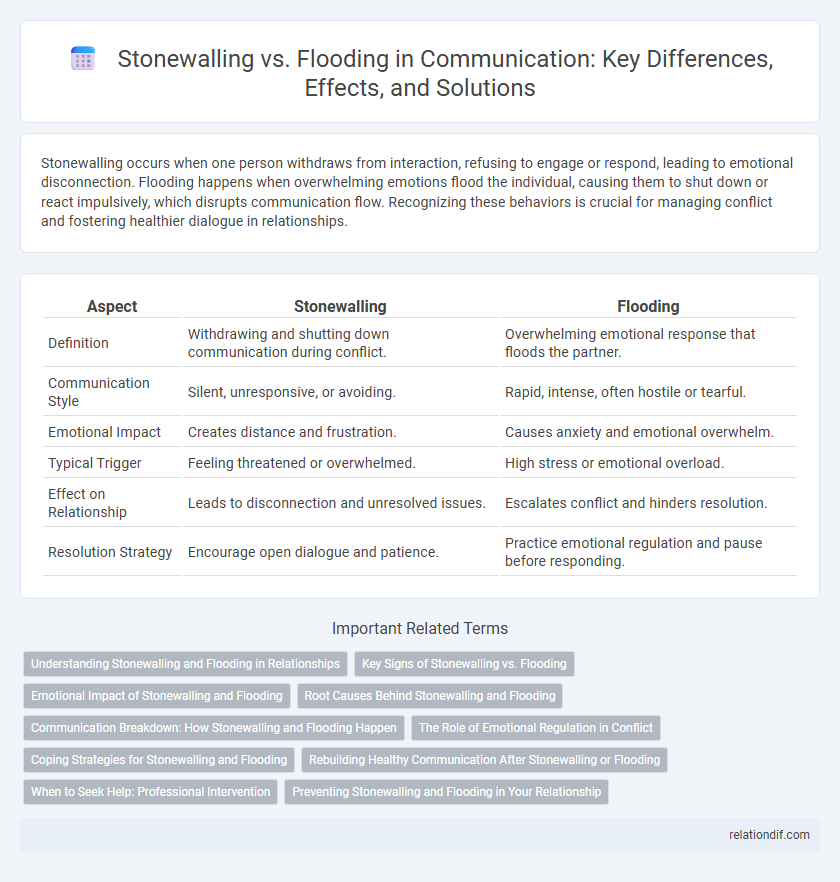Stonewalling occurs when one person withdraws from interaction, refusing to engage or respond, leading to emotional disconnection. Flooding happens when overwhelming emotions flood the individual, causing them to shut down or react impulsively, which disrupts communication flow. Recognizing these behaviors is crucial for managing conflict and fostering healthier dialogue in relationships.
Table of Comparison
| Aspect | Stonewalling | Flooding |
|---|---|---|
| Definition | Withdrawing and shutting down communication during conflict. | Overwhelming emotional response that floods the partner. |
| Communication Style | Silent, unresponsive, or avoiding. | Rapid, intense, often hostile or tearful. |
| Emotional Impact | Creates distance and frustration. | Causes anxiety and emotional overwhelm. |
| Typical Trigger | Feeling threatened or overwhelmed. | High stress or emotional overload. |
| Effect on Relationship | Leads to disconnection and unresolved issues. | Escalates conflict and hinders resolution. |
| Resolution Strategy | Encourage open dialogue and patience. | Practice emotional regulation and pause before responding. |
Understanding Stonewalling and Flooding in Relationships
Stonewalling in relationships occurs when one partner withdraws, shuts down, or refuses to engage during conflicts, creating emotional distance and frustration. Flooding refers to an overwhelming emotional response that causes a person to become hyper-aroused, making constructive communication difficult. Recognizing stonewalling and flooding patterns enables couples to address emotional regulation, improve conflict resolution, and foster healthier communication dynamics.
Key Signs of Stonewalling vs. Flooding
Stonewalling is characterized by withdrawal behaviors such as silence, avoiding eye contact, and stiff body posture, indicating emotional shutdown. Flooding involves overwhelming physiological responses like rapid heartbeat, sweating, and feeling mentally overwhelmed, often leading to intense emotional reactions. Recognizing these signs helps identify patterns that hinder effective communication and conflict resolution.
Emotional Impact of Stonewalling and Flooding
Stonewalling triggers feelings of rejection, frustration, and emotional isolation by shutting down open communication, leading to increased partner distress and emotional withdrawal. Flooding overwhelms individuals with intense negative emotions such as anxiety and anger, impairing cognitive processing and escalating conflict intensity. Both stonewalling and flooding disrupt healthy emotional regulation, contributing to deteriorating relationship satisfaction and increased risk of long-term relational damage.
Root Causes Behind Stonewalling and Flooding
Stonewalling often stems from emotional overwhelm, where individuals shut down communication to protect themselves from perceived judgment or conflict escalation. Flooding arises from intense emotional arousal, causing someone to feel mentally and physically overwhelmed, leading to a rapid, uncontrollable outpour of emotions. Both behaviors are rooted in stress responses triggered by unresolved conflicts and unmet emotional needs during communication.
Communication Breakdown: How Stonewalling and Flooding Happen
Stonewalling occurs when one partner withdraws from interaction, shutting down communication and refusing to respond, which causes emotional distance and unresolved issues. Flooding happens when one partner becomes overwhelmed by intense emotions, leading to rapid, defensive responses that escalate conflict and hinder constructive dialogue. Both behaviors disrupt effective communication by creating barriers to understanding and preventing resolution of underlying problems.
The Role of Emotional Regulation in Conflict
Stonewalling involves withdrawing from communication during conflict, often triggered by overwhelming emotions and difficulty in emotional regulation. Flooding occurs when intense negative emotions, such as anger or frustration, overwhelm an individual, leading to rapid and uncontrollable reactions that hinder constructive dialogue. Effective emotional regulation helps prevent both stonewalling and flooding, enabling healthier conflict resolution by managing emotional responses and promoting open communication.
Coping Strategies for Stonewalling and Flooding
Effective coping strategies for stonewalling include practicing mindfulness to stay emotionally present, setting time limits for breaks during heated conversations, and using "I" statements to express feelings without triggering defensiveness. For flooding, deep breathing exercises and grounding techniques help regulate physiological arousal, while pausing interactions to self-soothe prevents overwhelm and encourages constructive dialogue. Couples therapy often emphasizes these adaptive behaviors to reduce communication breakdowns caused by stonewalling and flooding.
Rebuilding Healthy Communication After Stonewalling or Flooding
Rebuilding healthy communication after stonewalling or flooding requires intentional efforts to recognize emotional triggers and establish safe, respectful dialogue boundaries. Implementing active listening techniques and setting time limits for discussions can prevent overwhelm and disengagement, promoting emotional regulation. Consistent practice of vulnerability and empathy fosters trust, enabling partners to move past communication barriers and nurture relational resilience.
When to Seek Help: Professional Intervention
Recognizing when stonewalling or flooding in communication escalates beyond personal resolution is crucial for healthy relationships. Persistent stonewalling, characterized by emotional shutdown and refusal to engage, or flooding marked by overwhelming emotional responses, often signals the need for professional intervention. Couples therapy or counseling can provide structured support to break these destructive patterns and foster effective communication strategies.
Preventing Stonewalling and Flooding in Your Relationship
Preventing stonewalling and flooding in relationships involves fostering open communication and emotional regulation to avoid withdrawal and overwhelming reactions. Establishing ground rules for conversations, such as taking breaks when emotions run high and practicing active listening, helps partners stay connected and responsive. Consistent use of calming techniques and expressing feelings constructively reduces the risk of escalating conflicts and promotes healthy dialogue.
Stonewalling vs Flooding Infographic

 relationdif.com
relationdif.com